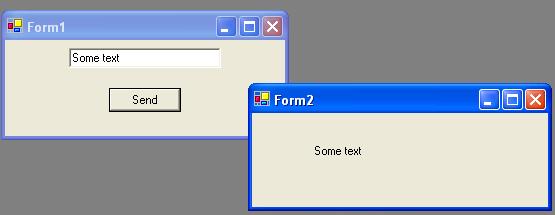There are so many methods (How many? I don't know) to pass data between forms in Windows application. In this article, let me take four important (easiest) ways of accomplishing this:
- Using constructor
- Using objects
- Using properties
- Using delegates
For data to be passed between forms using any of the above methods, we need two forms and some controls. Let us start by following the steps given below.
Thanks Code Project

Passing Data Between Forms
Step 1
Create a new project and select Windows application. This will create a default form as “Form1”. We can use this form for sending data.Step 2
Add atextbox and a button to the form.Step 3
Add another Windows Form for receiving the data and to display it. Right click the project and select Add->Add Windows Form. Enter a name or use the default name “Form2.cs” and click ok button.Step 4
Add a label to the second form to display the text fromform1.The Constructor Approach
This could be the easiest method of all. A method is invoked whenever you instantiate an object. This method is called a constructor. Code a constructor forform2 class with one string parameter. In the constructor, assign the text to the label’s text property. Instantiate form2 class in form1’s button click event handler using the constructor with one string parameter and pass the textbox’s text to the constructor.Follow the steps given below:
Step 1
Code a constructor forform2 class as below:public Form2(string strTextBox)
{
InitializeComponent();
label1.Text=strTextBox;
}
Step 2
Instantiateform2 class in form1’s button click event handler as below:private void button1_Click(object sender, System.EventArgs e)
{
Form2 frm=new Form2(textBox1.Text);
frm.Show();
}
The Object Approach
Objects are reference types, and are created on the heap, using the keywordnew. Here we are going to pass data using objects. The approach is simple; in form2 we are going to instantiate form1 class. Then instantiate
form2 in the button click event handler of form1. After this we are going to pass form1 object to the form2 using form2’s form1 object. The last step is to invoke the form2 window by calling the form2’s show method. Follow the below steps:
Step 1
Change the access modifier fortextbox in form1 to public:public class Form1 : System.Windows.Forms.Form
{
public System.Windows.Forms.TextBox textBox1;
Step 2
In the button click event-handler, add the following code:private void btnSend_Click(object sender, System.EventArgs e)
{
Form2 frm= new Form2();
frm.frm1=this;
frm.Show();
}
Step 3
In form2.cs, instantiateform1 class: public class Form2 : System.Windows.Forms.Form
{
private System.Windows.Forms.Label label1;
public Form1 frm1;
Step 4
InForm2’s Load method, type cast the object (frm1) of form1 to Form1 and access form1’s textbox and assign its text to label’s text. private void Form2_Load(object sender, System.EventArgs e)
{
label1.Text=((Form1)frm1).textBox1.Text;
}
The Properties Approach
Properties allow clients to access class state as if they were accessing member fields directly, while actually implementing that access through a class method. In this method, we are going to add one property to each form. Inform1 we are going to use one property for retrieving value from the textbox and in form2, one property to set the label’s text property. Then, in form1’s button click event handler, we are going to instantiate form2 and use the form2’s property to set the label’s text. Follow the below steps:
Step 1
Add a property inform1 to retrieve value from textbox:public string _textBox1
{
get{return textBox1.Text;}
}
Step 2
Add a property inform2 to set the labels’ text:public string _textBox
{
set{label1.Text=value;}
}
Step 3
Inform1’s button click event handler, add the following code: private void button1_Click(object sender, System.EventArgs e)
{
Form2 frm=new Form2();
frm._textBox=_textBox1;
frm.Show();
}
The Delegates Approach
Technically, adelegate is a reference type used to encapsulate a method with a specific signature and return type. You can encapsulate any matching method in that delegate. Here we are going to create a delegate with some signature and assign a function to the delegate to assign the text from textbox to label. Follow the below steps:
Step 1
Add adelegate signature to form1 as below: public delegate void delPassData(TextBox text);
Step 2
Inform1’s button click event handler, instantiate form2 class and delegate. Assign a function in form2 to the delegate and call the delegate as below: private void btnSend_Click(object sender, System.EventArgs e)
{
Form2 frm= new Form2();
delPassData del=new delPassData(frm.funData);
del(this.textBox1);
frm.Show();
}
Step 3
Inform2, add a function to which the delegate should point to. This function will assign textbox’s text to the label: public void funData(TextBox txtForm1)
{
label1.Text = txtForm1.Text;
}
 Note
Note